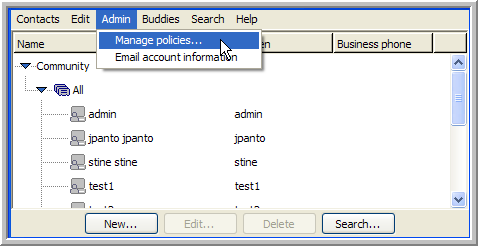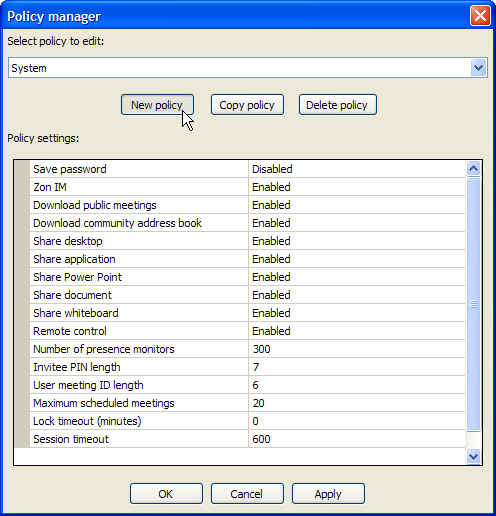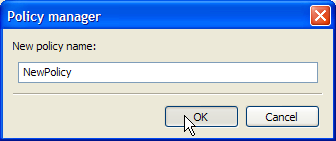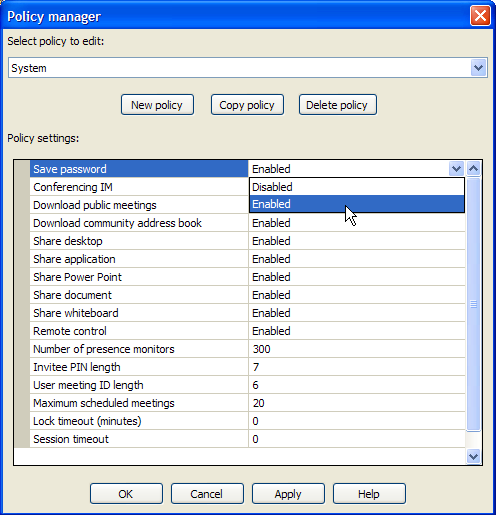4.1 Creating Policies
A policy is a set of privileges that governs the availability and limitations of certain features for a given user. Each user has a policy. Typically, an Administrator creates a small number of policies (appropriate for different levels of users) and assigns a policy to each user.
To create a new policy:
-
From the Conferencing client’s window, select the menu item.
-
In the window, click the button.
-
In the dialog that appears, type a name for your new policy and click .
-
In the window, click on the right column of the policy setting you want to change.
-
After you adjust all of the policy settings, click .
If you are creating a policy that is very similar to an existing policy, select the existing policy, click , provide a name for the new policy, and edit the settings.
When creating a new policy, you have the ability to configure the following policy settings:
Table 4-1 Policy Manager Settings
|
Save Password |
Allows the user to use the and features (if enabled) or requires that the user log in for every use of the client (if disabled).
When this feature is enabled, the user is provided with a option in the window. If this option is selected, Conferencing then stores the user's password locally in encrypted form. The next time the user accesses the client, Conferencing uses the locally stored password to perform an automatic login. |
|
Conferencing IM |
Allows or disallows Conferencing instant messaging and chat. This setting does not affect chat within the context of a meeting. |
|
Download Public Meetings |
Allows or disallows the display of public meetings in the window.
This setting is useful for large organizations. For more information, read the section immediately after this table. |
|
Download Community Address Book |
Allows or disallow the download of the .
This setting is useful for large organizations. For more information, read the section immediately after this table. |
|
Share Desktop |
Allows or disallows the ability to share one's desktop during a meeting. |
|
Share Application |
Allows or disallows the ability to share an application during a meeting. |
|
Share PowerPoint |
Allows or disallows the ability to share a PowerPoint* presentation during a meeting. |
|
Share Document |
Allows or disallows the ability to share a document during a meeting. |
|
Share Whiteboard |
Allows or disallows the ability to share the whiteboard during a meeting. |
|
Remote Control |
Allows or disallows the ability for meeting attendees to be given control of the presenter's desktop or application. |
|
Number of Presence Monitors |
Indicates the total allowable number of personal buddies. |
|
Invitee PIN Length |
The number of digits in a meeting PIN. |
|
User Meeting ID Length |
The number of digits in a meeting ID. |
|
Max Scheduled Meetings |
Indicates the maximum number of meetings the user is allowed to schedule. |
|
Lock Timeout (minutes) |
The number of minutes of inactivity before the user is required to unlock the client by entering a password. |
|
Session Timeout (minutes) |
The number of minutes of inactivity before the client is required to sign on again. |
The and policy settings are particularly useful for very large organizations. By disabling these settings, you enhance the performance of the client by not requiring it to download very large amounts of contact and public-meeting information that is most likely irrelevant for any one user.
Despite the utility of these settings, disabling them requires the user to search for contacts and public meetings that might be of interest to her or him. For example, if you disable the display of the for a user, the user has to use the feature to add a contact to the buddy list.
See the Conferencing online Help or Conferencing User Guide for detailed information on searching.
In summary, if you decide to disable the display of either the Community Address Book or public meetings, be sure that your users have the information or training they need to use search to locate contacts and public meetings of interest.



